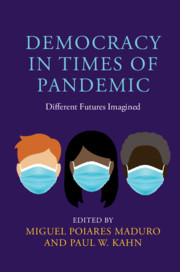Book contents
- Democracy in Times of Pandemic
- Democracy in Times of Pandemic
- Copyright page
- Contents
- Contributors
- Introduction: A New Beginning
- Part I Power
- 1 The Crisis of Democratic Leadership in Times of Pandemic
- 2 Executive Overreach and Underreach in the Pandemic
- 3 From Political Accountability to Criminal Liability: The Strange Case of French Penal Populism
- 4 Democracy and Emergency in Latin America
- 5 Apocalyptic Christianity, Democracy, and the Pandemic
- Part II Knowledge
- Part III Citizens
2 - Executive Overreach and Underreach in the Pandemic
from Part I - Power
Published online by Cambridge University Press: 04 November 2020
- Democracy in Times of Pandemic
- Democracy in Times of Pandemic
- Copyright page
- Contents
- Contributors
- Introduction: A New Beginning
- Part I Power
- 1 The Crisis of Democratic Leadership in Times of Pandemic
- 2 Executive Overreach and Underreach in the Pandemic
- 3 From Political Accountability to Criminal Liability: The Strange Case of French Penal Populism
- 4 Democracy and Emergency in Latin America
- 5 Apocalyptic Christianity, Democracy, and the Pandemic
- Part II Knowledge
- Part III Citizens
Summary
The pandemic that convulsed the globe in 2020 was long foretold but still surprising to many. Within a few months of its appearance, COVID-19 became one of the leading causes of death worldwide. Governments struggled at first to comprehend what was happening – and then reacted in very different ways. Most political leaders followed the advice of epidemiologists. Many declared states of emergency. A few pursued autocratic agendas. And some did almost nothing.
During emergencies, constitutional scholars normally worry about executive aggrandizement at the expense of human rights and democratic values. Emergencies often require national executives to act quickly and forcefully to stave off threats. But emergencies also give national executives the opportunity to consolidate power, just when parliaments and courts are least keen to take responsibility. As we will show, the pandemic has provided a textbook example of this phenomenon, reinforcing what we know from the literature on emergencies that “executive overreach” is a serious problem.
- Type
- Chapter
- Information
- Democracy in Times of PandemicDifferent Futures Imagined, pp. 38 - 53Publisher: Cambridge University PressPrint publication year: 2020
- 2
- Cited by



